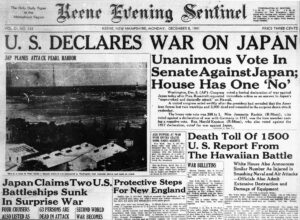Phillip Douglas Parady
The Ring of Eternal Patrol
Starting in 1934, at the age of 12, Phillip Douglas Parady spent four summers attending Boys Sessions in July at YMCA Camp Takodah.
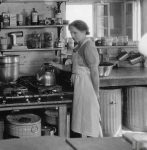
That same year, Mrs. Kate Davis donated a small patch of land, which would be named for her late husband, on the western side of the Y’s rapidly expanding property. Phillip returned to camp in 1935, the year Elsie Crowninshield came from Northfield Seminary for Young Girls to start her long career as our legendary cook and divisional namesake. In 1936, Takodah purchased its first sailboat and Phillip was likely one of the earliest campers to use it. By the time 1937 rolled around, no one at camp, including Phillip, knew that the following year the campus would be completely transformed by the Great New England Hurricane.
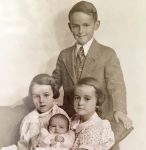
As Phillip matured, he took every chance he could to learn, grow, develop, and shape himself into an individual of tremendous personal character. He was close with his family, especially his mother, Dorothy, and his sisters. A quote in his yearbook entry for the Keene High School Salmagundi read:“what should a man do, but be merry?”
And that’s exactly how “Phil” lived his life.

He was a cheerleader, a yearbook board member and a school business manager. He was an active participant in the Biology Club, Dramatic Club, French Club, the band, orchestra, and DeMolay International, where he was a recognized, state-wide Past Master Counselor. After graduation in May 0f 1940, he worked in the office of an insurance company that is still located in downtown Keene, New Hampshire.
Over the course of the next year and a half, Phillip watched closely as Europe was plunged into chaos and conflict. The Axis powers were posing an increasing threat to the stability of freedom and democracy around the world. From newsreels to newspapers, the writing was on the wall. And then, one cold day in early December 1941, Phillip picked up a copy of the Keene Evening Sentinel and he immediately knew what he had to do.
On 31 December 1941, Phillip, like so many other brave men around the country at that time, enlisted in the United States Navy in Springfield, Massachusetts. He was 5’8″ tall and weighed just 125 pounds.
After taking a few days to get his affairs in order, he set off for war deployment with a patriotic mindset and a few precious photos including one picture of his longtime girlfriend Frances Paula Kelly, affectionately known as “Puggy,” and one picture of his dearest Mother. At Phillip’s request, Dorothy had taken the photo for her son with a local photographer even though money was limited for the family as the region continued to recover from the economic depression.
After all, she clearly understood where Phillip was going and what price he could pay. Dorothy, like so many other brave mothers around the country at that time, made sure her son had as best a sendoff as she could possibly provide.

Phillip processed through Newport, Rhode Island, on 1 January 1942 where he qualified as an Apprentice Seaman. His pay was $21 per month and he was quickly assigned duty in USS Wyoming, an old battleship originally commissioned in 1911. Unlike many of his compatriots, Phillip did not attend standard military basic training. Instead, after reporting aboard the training ship on 22 January 1942, he learned by doing.
Hundreds of new Sailors, including Phillip, learned Navy customs and courtesies, seamanship and basic naval combat skills which included operating .50 caliber anti-aircraft guns and firing the larger, more complex 5-inch dual-purpose guns.
During this training period, Sailors were constantly tested and evaluated, with those scoring the highest assigned to the most challenging and technically-demanding rates. Wyoming spent so much time operating out of Norfolk, Virginia, that summer that she earned the nickname “Chesapeake Raider.”

That summer, after being promoted to Seaman Apprentice second class, Phillip took his shore leave at home where he spent time with Dorothy and Puggy. He was proud to show off his smart looking Navy uniform. While she was equally proud to see it, Phillip noticed that the uniform also made his mother fall quiet as she contemplated his role in the rapidly escalating and dangerous war.
In the fall of 1942, Phillip attended Quartermaster “C” school in Newport, RI. He learned navigation, chart reading, compass and gyro operation, ship steering, watch duties and keeping official logs and records. He was promoted to Quartermaster third class on 24 November 1942.
Three days later, Phillip transferred to the submarine training school in New London, CT where he was subjected to an intensive program meant to prepare him for a life beneath the waves. The submarine service, like aviation and intelligence, was among the most technically advanced branches in the Navy, requiring smart, adaptable enlisted Sailors.
It was a perfect match for a talented young man like Phillip.
Not only were Sailors given psychological tests to see how well they would adapt to serving in the small, cramped confines of a submarine. The men were also cross-trained in the many critical tasks needed to keep a steel submersible afloat. As the submariners used to joke, “a submarine is the only commissioned Navy warship which deliberately sinks itself,” and they want to make sure it surfaces again.

Phillip spent the next two months at the Basic Enlisted Submarine School, learning the varied skills needed for this hazardous, dangerous life, including stopping leaks and fighting fires – the two most dangerous threats in a submerged submarine. In typical Navy fashion, of course, the Sailors switched between calling their craft a ‘boat’ or a ‘fleet submarine,’ when it was neither of these things. Technically it was a submersible (not a true submarine), since it was powered by diesel-electric engines while on the surface. Indeed, the fleet boats spent most of their service lives cruising on the surface (since diesel engines require oxygen to burn fuel), with only short-term batteries available for power when submerged. Another nickname was “pig boat,” partly because the diesel engines “snorted like a pig.” Its main weapons were torpedoes, of which they carried a dozen or more, and a 3-inch deck gun, which could be used to attack lightly armed merchant ships when on the surface.
On 1 December 1942, Phillip completed his submarine escape tank training and was declared fit for service in submarines. Two weeks later, he started Submarine & Quartermaster, Signal School.
“Life aboard WWII submarines was brutal,” as James Elphick wrote for We Are The Mighty in 2017.
“Each crewmember had only about one cubic foot of personal storage space aboard the sub. Each crewmember also had a bunk, scattered throughout the many compartments of the boat, including in the torpedo rooms. As many as 14 men crammed into the forward torpedo room along with 16 torpedoes. A submarine of that size simply could not fit all of the necessary provisions for a long war patrol in the appropriate spaces. To accommodate, the crew stashed boxes of food and other things anywhere they would fit — the showers, the engine room, even on the deck until there was space inside to fit it all. ”
There was one upside though. Because of the dangerous and grueling nature of submarine duty, the Navy did its best to ensure that submariners got the best food the Navy had to offer. They also found room to install an ice cream freezer as a small luxury for the crew.

Successfully graduating submarine school in late March 1943, Phillip was immediately transferred to the submarine service. He departed New London on 22 March by train and reported to Receiving Ship, San Francisco four days later.
After making his way to Hawaii, he joined veteran fleet boat USS Plunger (SS-179) on 18 April 1943, just in time for three days of underway training exercises out of Submarine Base Pearl Harbor. This was also his first dive in a submarine, which is a disconcerting experience for anyone. But he didn’t panic and, after returning to port on the 20th, he and the rest of the crew spent two days loading food, supplies and ammunition before getting underway for Plunger’s sixth war patrol (and Phillip’s first) on 23 April.
Lieutenant Commander Raymond H. Bass, a future Rear Admiral and Navy Cross recipient, was in command.
Ordered west to patrol in the Marshall Islands, Plunger first stopped at Johnston Island on the 25th, where the crew delivered mail and received fuel, oranges, and beer on Easter morning.
The beer was stored for a “steel beach picnic,” a celebratory event (two beers per man) at the Skipper’s discretion. They typically held these parties toward the end of a successful war patrol. Departing soon after, the ‘Old Man,’ as the skipper was called, put the eight officers and sixty-five enlisted men through unannounced attack drills every day, including three training dives and multiple fire control and interior communication exercises. As noted in the war patrol, the many hours of training produced dividends later that “made our pockets jingle.”

Starting on 1 May, Plunger began to encounter Japanese aircraft patrols, each spotting forced the boat to dive to 140-feet and wait an hour before surfacing. A silver lining was the discovery (and repair) of a compressed air leak in the number 4 main ballast tank, which at 70-feet “looked like the bubble scene in ‘Fantasia’.” The crew also spent time trying to repair a broken impeller shaft in her #1 main engine and a seal in the antennae trunk popped, flooding the mast chamber with salt water.
The war diary noted that “it was not a happy day.”
Plunger then steered west by southwest to the Caroline Islands, where she patrolled north of Truk hoping to spot an expected Japanese convoy. At this stage of the war, American codebreakers were reading some Japanese encrypted radio traffic and target information was often passed on to submarine skippers. After a few fruitless days, she spotted her convoy of four merchant ships and one escort late on 8 May and spent the evening maneuvering into attack position.
At 0249 on 9 May, Plunger submerged to 35 feet and closed to attack, using radar and periscope to develop target solutions for her torpedoes. Phillip, as part of the bridge crew, would have been intimately involved in the process – either helping steer the sub, or operating the dive planes or helping with navigation and targeting. At 0315, the crew fired three torpedoes from 1,600 yards, a relatively close range, at Kunikawa Maru, a Japanese seaplane tender. The two torpedoes that hit only partially exploded (likely owing to faulty impact detonators). The tender suffered only minor damage to her port bow. The convoy escort Hiyodori, an Ōtori-class torpedo boat, retaliated with depth charges but Plunger slipped away undamaged. After reloading her torpedo tubes, the boat surfaced at 0412 and started tracking the convoy under propulsion from her three operational diesel engines.

As Plunger tried to skirt around the rear of the convoy at dawn, the Japanese saw the boat silhouetted against the horizon and began firing anti-aircraft guns. While no shots came close to hitting her, given the range was 13,000 yards, it was alarming because daylight made Plunger vulnerable to aircraft patrols. Oddly, the surface escort did not move in her direction nor did any aircraft patrols show up that day, allowing the submarine to run entirely along the convoy’s flank and take up a submerged attack position by 1547 that afternoon.
Just over an hour later, Plunger’s crew fired three torpedoes at a range of 2,200 yards at the lead ship in the starboard column, followed by a fourth at the second ship. The submarine then went all ahead full, left full rudder, to bring her stern tubes to bear. The Skipper took a quick look at the escort, about 2,500 yards off the target’s starboard quarter, before hearing torpedo hits echo through the water. He raised the periscope and saw both targets enshrouded in smoke, then saw the escort now closing Plunger’s position at speed. Commander Bass quickly ordered “take her deep” and over the next five minutes the escort dropped ten depth charges over Plunger‘s wake, though none were close enough to damage her. After waiting an hour to let things settle down, Plunger began a surface pursuit of two large ships seen on the horizon.
The chase lasted all night, as it was a cloudy, moonless evening.

Finally, at 0503 on 10 May, Plunger fired four torpedoes at a range of only 700 yards, damaging Kinai Maru, a 8,360-ton troop transport, with three hits. Hiyodori dropped six depth charges in response, but none close. Coming up to periscope depth a few hours later, Plunger fired two torpedoes at Tatsutake Maru at 0835 as the freighter maneuvered to rescue about 400 troops and passengers from Kinai Maru. Both torpedoes hit in a white geyser of water and debris and the freighter quickly sank, exploding in an orange fireball as she slid under the surface.
With only three torpedoes left, Plunger stayed submerged and maneuvered to try and get another firing solution on the damaged Kinai Maru, then listing 10 degrees to port but not sinking. With full light, however, came Japanese search planes and “for the next hour planes were everywhere…” The Skipper, worried about possible air attacks, creeped Plunger in close for a stern shot. When the range was estimated to be 1,000 yards the Skipper raised the periscope for a final look and, as noted in the war diary, he saw “a lot of gray paint and the [Maru’s] bow. Flooded negative, ordered 90 feet and listened for a loud grating noise.” Luckily Plunger had dived fast enough and Kinai Maru passed just over her. Coming up to periscope depth 10 minutes later, Plunger fired her two stern tubes and got one hit, and then hit the freighter again with her last bow torpedo a few hours later.
The last shot hit “with the crack and reverberation of a depth charge.”

Annoyingly, given that she’d taken four torpedo hits, Kinai Maru refused to sink. Given her low battery charge, Plunger moved away to surface and recharge that night. In the morning she returned at 0515 on 11 May and saw the ship abandoned, with no planes or escorts in sight. Which was true, as Hiyodori had rescued all her remaining crew and passengers and had already steered for Saipan. Plunger’s crew battle surfaced at 0546 and spent the next 30 minutes in gunnery practice, firing 180 3-inch and about 1,000 20mm shells into the freighter. Just to make sure the weapon worked, they also fired 100 rounds from the .50-caliber machine gun. Kinai Maru caught fire relatively quickly and burned for several hours before finally sinking at 0932 that morning.

With all tubes empty, Plunger steered for home. Despite losing #3 main engine on the 14th owing to a broken blower, she moored at Pearl Harbor on 22 May. Plunger and her crew were credited with at least two ships sunk, a successful war patrol.
Given Plunger’s scheduled two weeks in the shipyard to repair her engines, Phillip was transferred to the USS Pompano (SS-181), another Porpoise-class submarine which needed replacement Sailors. While he got a few days of rest and caught up on sending some letters home, the intense pace of the submarine war meant very little downtime and within days he was helping his new crew load fresh food and supplies.

Underway for her sixth war patrol on 6 June, Lt. Cdr. Willis M. Thomas in command, Pompano proceeded to Midway Island to refuel and load fresh water before heading west to the Japanese home islands.
After an uneventful cruise in calm weather, the submarine took up her first patrol position near Tori-shima, an island about 375 miles south of Tokyo, on 19 June. Given the possibility of air patrols, the Skipper kept Pompano submerged during the day, only surfacing at night to recharge batteries and get some fresh air pumped inside the cramped, humid interior.
On 15 June, Phillip qualified as a radar operator. From that point on, he would have been in the conn alerting the Skipper to both enemy aircraft as well as surface contacts.
On 20 June, the submarine spotted 5 fishing boats nearby but did not attack to keep presence unknown. The following morning Pompano made radar contact with two freighters and an escort but could not get into firing position before dawn. Later in the day, given increasing cloud cover, the Skipper surfaced and conducted a search along probable course but never found the convoy owing to increasing rain. On 23 June, having not seen any aircraft patrols, the Skipper started surface patrols during the day. In theory this would produce more contacts, as the radar mast could be raised much higher than when submerged, but the patrol area proved stubbornly empty.
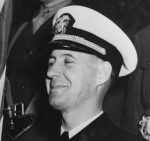
Over the next week Pompano only spotted ships on two occasions, a small sailing ship on the 24th and three small fishing boats on the 29th. At the same time, the submarine’s air search radar started to pick up enemy air patrols, forcing her to dive on three occasions. On 30 June, the Skipper sent a radio message to Hawaii asking permission to search closer to Tokyo but received no reply. Finally, on 3 July and in line with her written orders, the submarine switched her patrol area to the coast southeast of Nagoya, Japan.
On the fourth of July, while patrolling off the mouth of the Tenryu River near Hamamatsu village, the Skipper sighted a large freighter beached southwest of Kaketsuka lighthouse. This was Sagara Maru, a seaplane tender damaged and deliberately grounded ten days earlier after an attack by USS Harder (SS-257). Despite fog and rain, the Skipper closed to within 3,300 yards and conducted a night radar attack on the tender, scoring two hits out of three torpedoes fired.

Sagara Maru was later written off as a total loss.
The poor weather would prove frustrating as the month wore on. Lookouts were plagued by fog and mist, the low visibility sometimes hiding Japanese air patrols. On the morning of 5 July, after moving south to Daio point near Shima, Pompano sighted a small convoy of 4 freighters, a tanker and an escorting destroyer. Unable to surface owing to daylight, she managed to close to 2,500 yards and conduct a submerged attack with four torpedoes on the last freighter in the convoy. All torpedoes missed, likely to underestimating target speed.
At 0100 on 6 July, she sighted 2 freighters by radar in the same area and tried again. Visibility was poor, but Pompano obtained a firing solution and targeted the lead freighter with three torpedoes at a range of 2,300 yards. Again, no hits, possibly due to incorrect torpedo depth settings. On 9 July, she attempted a night surface radar attack on a Japanese destroyer with two bow torpedoes. The second torpedo suffered a gyro error, broached and accidentally exploded 8 seconds after firing. Alerted, the destroyer evaded the first torpedo and dropped a few depth charges, though, once again, none were close enough to damage Pompano. On the 10th, they tried yet another night surface attack, this time with two stern torpedoes at 2,700 yards, and both missed ahead.
For the next week Pompano’s crew remained frustrated, both by poor weather, heavy air patrols and the intermittent loss of her “SJ” surface search radar and worries over whether the targeting computer was working correctly. The torpedo maintenance crewmen spent many hours going over Pompano’s last two torpedoes, desperately trying to make sure they would run correctly.
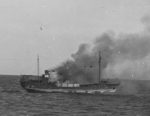
The night of 17 July, Pompano closed a large fishing sampan that was tending nets with her lights on. The submarine battle surfaced and began firing 3-inch shells at 900 yards. She made 10 hits out of 17 3-inch shells fired and then opened up with two 20mm antiaircraft guns and a .50-caliber machine gun, which “made a shambles out of what the 3-inch gun left.” The sampan was left a wreck, two-thirds submerged with her fishermen crew dead or in the water.
Pompano’s final attack of the patrol took place early on 20 July, when she closed a large freighter off Daio point. The sky was clear and the seas rough, so she had difficulty staying at periscope depth. She fired her last two torpedoes at 2,400 yards but to no one’s surprise they both missed.

Largely frustrated and unhappy with their boat, their Skipper and themselves, the crew turned for home, eventually mooring at Midway on 28 July. To Phillip, having only been exposed to Plunger’s successful patrol, the months of June and July 1943 were doubtless a morale killer. This was made worse by the realization that Pompano was ordered to stay in Midway for a refit, so there would be no Hawaiian beaches for him or his comrades. It was also depressing to learn Pompano’s last war patrol was labelled “unsuccessful,” and that “it is regretted that more damage was not inflicted upon the enemy.”
During this time, Phillip had a chance to read and respond to his mail. He received letters inquiring about his health from his mother and loving correspondance from Puggy. He carefully crafted responses so that his words would neither concern the US Navy censors nor upset the two special women in his life both of which he adored to no end.
Close to three weeks after arriving at Midway, a refitted and resupplied Pompano conducted torpedo firing and radar training with submarine rescue ship Florikan (ASR-9) south of Midway on 17 August. She then sailed for her seventh war patrol to Hokkaidō and Honshū on 20 August.
She was never heard from again.

A post-war review of Japanese records suggest Pompano likely sank Akama Maru, a 6,000-ton cargo ship, southeast of Hokkaidō on 3 September. From there, the submarine proceeded south to the northeastern coast of Honshū.
While it was initially thought that Pompano had struck a mine and sank, Japanese records indicate that on the morning of 17 September an Ominato-based floatplane spotted an oil slick two miles from Cape Shiriya Zaki. As the slick appeared to be moving faster than the current, a possible sign of a submerged submarine, the floatplane dropped two depth charges and then alerted Ominato Naval District HQ of the sighting.
Submarine chase CH-41 and patrol boat Miya Maru were dispatched to the area and at 1010, Miya Maru made three depth charge attacks. An hour later converted patrol boats Higashi-Nippon Maru and Mizuho Maru arrived and each made one additional depth charge attack. These five depth charge pattern attacks reportedly stopped the submerged target, which continued to leak oil.
Two hours later, minelayer Ashikaze arrived from Hakodate and minelayer Ishizaki from Muroran. At 1340, Ashizaki made a carefully timed depth charge run and a large quantity of oil boiled to the surface, like blood from a wounded whale. At 1450, Ishizaki made a follow-up attack, further widening the oil slick. Later in the day, Ashikazi made a final attack with a 7-depth charge pattern and reported the enemy submarine sunk.

QM3 Phillip Douglas Parady and the gallant crew of USS Pompano most likely made the supreme sacrifice just under two miles from the Japanese coast, not far from the Shiriyazaki Lighthouse.
Within a matter of weeks, she was presumed lost after failing to return to base at Midway.
Not too long after, William Ira Francis Parady, Phillip’s father, received a telegram from the Chief of Naval Personnel, that read in part:
I extend my deepest sympathy to you in your sorrow. It is hoped that you may find comfort in the knowledge that your son gave his life for his country upholding the highest traditions of the Navy.
William then took the most difficult walk of his entire life. He met Phillip’s mother and sister in downtown Keene, right near the restaurant where Dorothy worked as a bookkeeper. They crossed the street into Central Square, he asked them both to sit down, and then he delivered the awful news. The news no parent ever wants to give or receive. The news that changes families once and forever.
Phillip was missing and presumed lost at sea.

It was the darkest of days for William and Dorothy. It was a conversation that never left them.
But, Dorothy, knowing that Phillip had led a merry life of optimism and happiness, thought not of herself and her own deep despair. Instead, she thought of Phillip’s precious Puggy.
Phillip had confided in her, shortly before he deployed, that he planned to give Puggy a ring upon his return and ask for her hand in marriage. And so, Dorothy, a grieving Gold Star mother suffering a loss no one should ever have to feel, immediately went to the local jeweler and purchased an engagement ring.
She brought it to Puggy, told her it was from Phillip, and proceeded to give her the terrible news. With tears flowing and sentiments of sorrow being shared, they held each other for a long time. The small golden ring, with a diamond that will last as long as Phillip’s eternal patrol, reminded Puggy of the man that brought cheer where ever he went. A man they would love forever.
A man no one would ever forget.
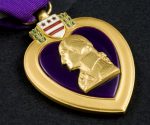
Phillip was posthumously awarded the Submarine Combat Patrol Insignia on 31 January 1944. He was officially declared dead and awareded the Purple Heart on 6 September 1946. He was memorialized in an extinct volcano at The Courts of the Missing along the Honolulu Memorial.
The medals he was awarded in service to a grateful nation include Combat Action Ribbon, World War II Victory Medal, American Campaign Medal, Distinguished Unit Citation, Good Conduct Medal, Asiatic-Pacific Campaign Medal, and a Navy Expeditionary Medal.
The USS Pompano received seven battle stars for her service in the war. Despite repeated attempts by the Navy, the wreck has never been found.

Read the next story in the series.
Return to the Lost Takodians of WWII main page.
SOURCES:
- Parady-relation family letters, clippings, interviews, and documents
- YMCA Camp Takodah Thumbnail History, Oscar & Francis Elwell, 1971. Takodah YMCA Archives.
- YMCA Camp Takodah Registration Cards. Takodah YMCA Archives.
- “The Whistling of the Winds and the Transformation of Camp Takodah” – YMCA Camp Takodah Blog, Graeme Noseworthy, 2017
- Keene Evening Sentinel
- Historical Society of Cheshire County
- Ancestry.com Records, Media, and Parady Family Trees
- Fold 3 Records, Media, and Military Documents for QM3 Phillip Douglas Parady
- Official Military Personnel Record, Department of the Navy, National Personnel Records Center, National Archives, St. Louis, MO.
- Newspaper Archives
- Newspapers.com
- Submarine Force Library and Museum Association
- “Life aboard WWII submarines was brutal” – James Elphick, We Are The Mighty, 2017
- USS Plunger, Wikipedia
- Kini Maru, Wikipedia
- USS Pompano, Wikipedia
- Tatsutake, CombinedFleet.com
- Kunikawa Maru, CombinedFleet.com
- The Loss Of The USS Pompano, USS Nautilus.org
- USS Plunger, muster 30 April 1943; 31 May 1943.
- USS Plunger, Sixth War Patrol Report, 23 April to 22 May 1943.
- USS Pompano, muster 30 June 1943; MIA report, 15 October 1943.
- USS Pompano, Sixth War Patrol Report, 6 June to 28 July 1943.
- USS Wyoming, muster 27 January 1942; 30 June 1942; 31 August 1942; 30 November 1942.
- Hackett, B., Kingsepp, S., Cundall, P. (n.d.). Record of Movement, IJN Subchaser CH-41, Imperial Japanese Navy page.
- FindAGrave.com
- American Battle Monuments Commission
PHOTO CREDITS:
- YMCA Camp Takodah Photo Archives
- Krepps & Campbell Family Photos
- Naval History and Heritage Command
- Nelson Family Photos
- Wikimedia
- National WWII Musuem
- US Naval Institute Blog
- American Battle Monuments Commission




